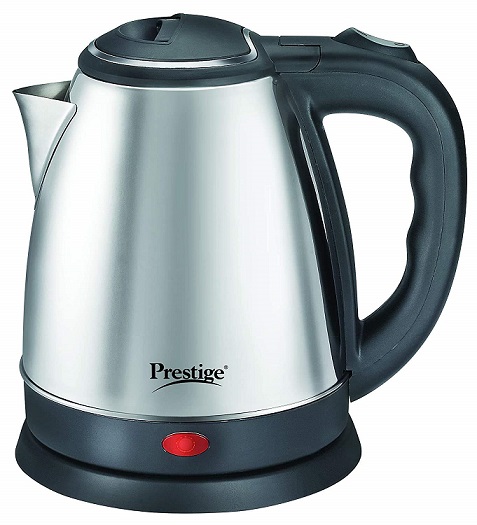Whether you can boil milk in an electric kettle or not has always been a tricky question. Using an electric kettle to boil or heat milk is definitely a convenient and time-saving process. This is the reason most users feel tempted to do so.
In this article, we have tried to solve all these queries by mentioning the ways using which you can boil milk in an electric kettle. Along with this, we have also mentioned what scenarios you can expect while using an electric kettle to boil milk. Let’s learn more about it!
Can we Boil Milk in an Electric Kettle?
Electric kettles are designed for heating or boiling water. However, you can use them for boiling milk as well. But you will have to be a bit careful.
How to Boil Milk in an Electric Kettle?
You can follow the steps mentioned below to boil milk properly in an electric kettle:
- Pour a glass of milk (or the required quantity) into the kettle and keep the lid open.
- Turn on the electric kettle.
- Keep your eyes on the kettle throughout the process as the chances of overflowing of milk is high.
- Once the milk starts heating up, give it a stir at frequent intervals using a tablespoon.
- Keep some water aside (a quarter-cup should be enough).
- Once the milk starts boiling and when you notice that it is going to overflow, lift the kettle up and add a little bit of cold water (1-2 tablespoon) to it. This process will prevent milk from overflowing.
- You can now transfer the milk to a cup or glass. It hardly takes 20-30 seconds to boil the milk.
Note: Always buy a jointless electric kettle if you want to use it for boiling milk. It will help in making the cleaning task more manageable.
How to Boil the Milk in an Electric Kettle Without Burning it?
Here is an alternative way of using electric kettle for boiling milk without burning it.
- Pour the required amount of milk in a container that has a lid (preferably a steel container). Cover the container with the lid.
- Now pour some water in the electric kettle and place this container inside the kettle carefully.
- Close the lid of the kettle and turn the switch on.
- Leave it for 10-15 minutes.
- Turn off the machine and remove the container. As it is going to be very hot, take out the container carefully.
- Open the lid of the container and the hot milk is ready.
- You can transfer the milk to a glass or a cup and enjoy drinking it.
Possible Scenarios/Mishaps that you can Face while Boiling Milk in an Electric Kettle:
Even though it is quite easy to boil milk using an electric kettle, here are some possible scenarios that you might expect:
1. Rather than Evaporating, the Milk Might Spill Over the Kettle.
Unlike water, milk features different properties. When you heat water, it evaporates but milk does not evaporate and this might lead to spilling, causing an unnecessary mess.
Milk is a combination of water, fats, and protein. Hence, when you heat milk, the fat and protein components start getting separated from the water. Due to this, a separate layer is formed over the top of the milk preventing the water from evaporating. It is the reason why milk starts boiling rather than evaporating. Sometimes, the overflowing of milk from the kettle might lead to a short circuit in the kettle’s electric base. In worst-case scenarios, it can completely ruin the electric kettle too.
2. The Electric Kettle Might Not Turn-off Automatically, Leading to the Burning of the Milk.
Usually, electric kettles shut down automatically as soon as the steam reaches the top part of the kettle. After reaching the top, the steam moves down a tube that results in expanding of a bimetallic plate. It then trips off the switch. As the topmost layer of protein and fats prevents an excessive amount of steam coming from the milk, the kettle might not shut off and by the time you notice, the milk might keep boiling until the water present in it evaporates completely. Meanwhile, the protein and fat content get burnt inside the kettle.
3. Milk can Leave some Sticky and Fatty Residue Behind in the Kettle.
Since milk contains protein and fat, it leaves a sticky residue behind after you heat or boil it. If the design of your electric kettle is a bit complicated, then it can be difficult to scrub and remove all the residues that settled at the bottom and sides of the kettle. The residue sometimes sticks to crannies and the nook of the electric kettle as well. This can hamper the overall functionality of the kettle over a period of time. Deposits of milk or its residue over the heat sensors can also damage the appliance.
4. The Kettle can Stink a Bit After Boiling Milk.
The burnt milk deposits are not only difficult to clean but also leave unpleasant odours similar to burnt cheese. Due to this, drinks you are going to make next in the kettle might taste and smell bad too. They will have the flavour of burnt milk.
Conclusion:
Thus, if you want to boil milk in an electric kettle, you will have to be extra careful while using and cleaning it. Along with this, there are some models of electric kettles that are designed especially for boiling milk. You can buy them as an alternative.


